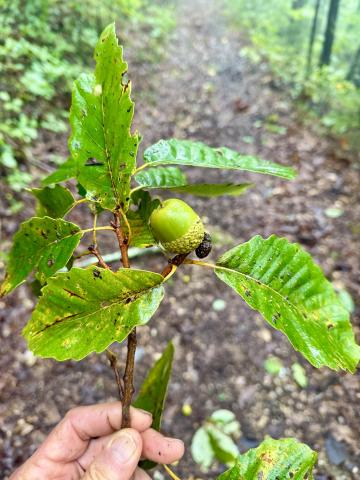Chestnut Oak

Chestnut oak acorns are plentiful this year and are the largest acorns we have locally. They provide an important wildlife food source.
By Steve Roark
Volunteer Cumberland Gap National Historical Park
The most common forest type we have in our area is called Oak-Hickory, meaning those two trees are commonly found in the forest mix. There are several species of both hickory and oak, and one of the easier oaks to find and identify in the woods is Chestnut oak.
The scientific name for Chestnut oak is Quercus montana, which means “oak of the mountains”. This is a fitting name because chestnut oak normally populates the upper dry ridges of our mountains, and able to eke out a living on dry, shallow, rocky soils.
Chestnut oak is easy to identify by its leaves, which are leathery, around six inches long and 3-4 inches wide. The leaf margin has a series of short, rounded lobes the size and shape of the end of a butter knife. Chestnut oak can also be identified by its bark alone. It’s the thickest barked tree in the forest and appears as rows of wide ridges separated by fairly deep furrows. The color is a gray-brown, and once you see it you won’t confuse it with anything else. The acorn is the largest of all the oaks around here and can reach 1½ inches in length. If you want to see a chestnut oak, just take a hike on top of a forested ridge and you’ll find it. It’s commonly found growing with scarlet oak, blackgum, and red maple.
How the tree came to be called chestnut oak is uncertain. One reference said it was because the leaves resemble those of American chestnut, and the two trees once grew side by side until a blight took out the chestnut, a sad forest story. I don’t think chestnut oak looks anything like an American chestnut leaf, so I disagree with this reference. Another thought is that American chestnut bark was once the primary source of tannic acid, used by the leather making industry back in the day when leather was in great demand for shoes and horsepower equipment such as saddles and horse harness. Chestnut oak bark was a close second as a source of tannins and so may have been named chestnut for that reason. The process of tanning leather involved cleaning and scrapping the animal hide to a stable condition called rawhide. The rawhide was then converted to leather by soaking it in a vat of water and tannin rich bark for several months, which shrank and stabilized the animal skin cells to make it pliable and durable. The use of tree bark for this process goes way back. The word tannin comes from the ancient Celtic work “tannum”, which means “oak bark”. Chestnut oak was in such demand for its bark that it was also referred to as tanbark oak, and it wasn’t unusual for large trees to be cut down, stripped of their bark, and left to rot in the woods.
Chestnut oak is still used by both man and beast, the wood being a good source of oak lumber, and the acorns an important food source for deer, squirrel, turkey, and many other species. Like all oaks, acorn production is sporadic, with good crops occurring only every 4-5 years. In a good mast (acorn) year like we have this year, a single chestnut oak can produce 300 pounds of fruit, but only maybe 10 pounds in a non-mast year.
- Log in to post comments